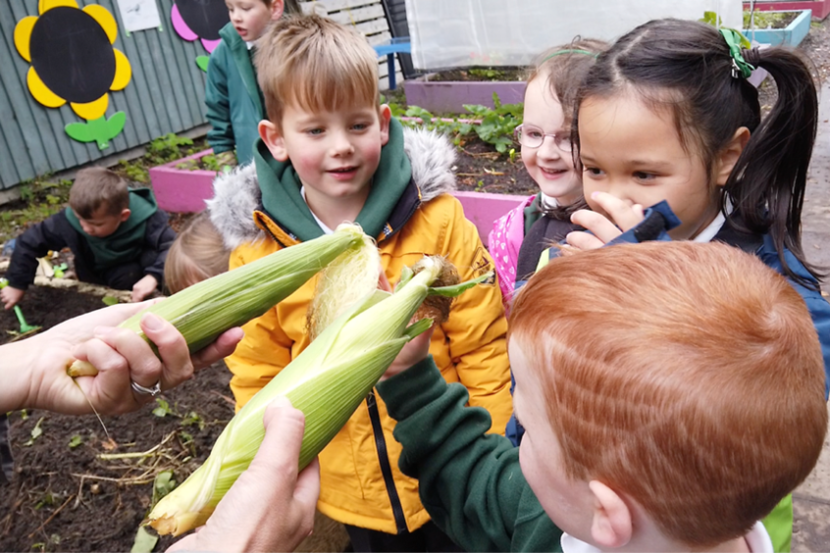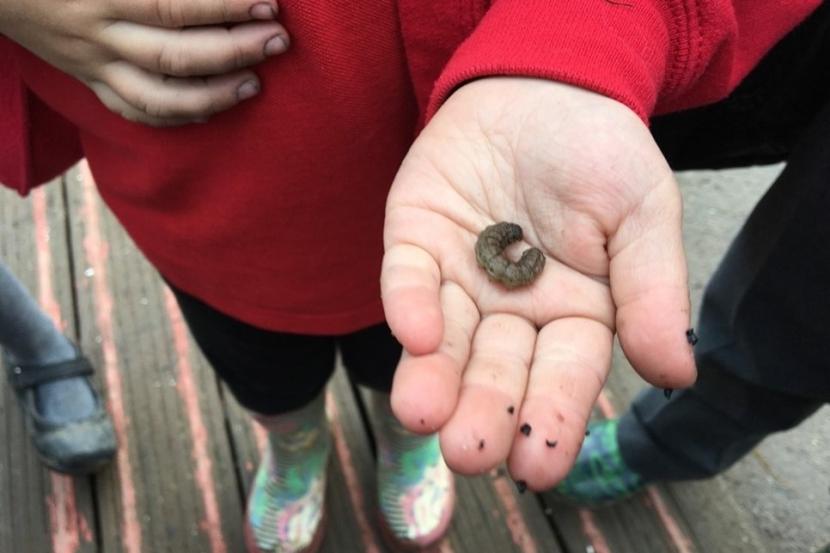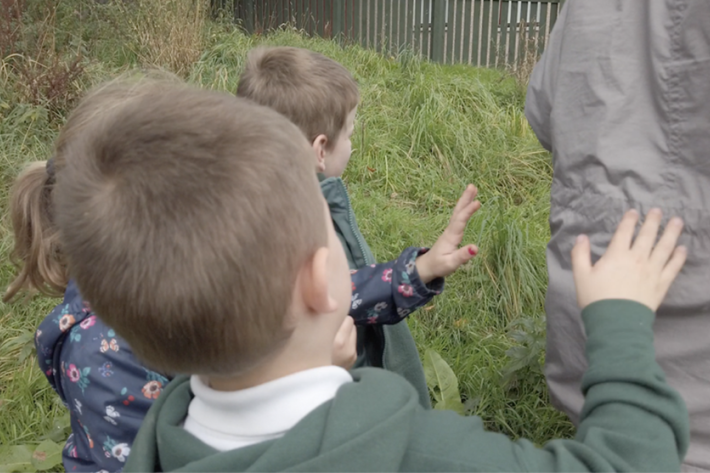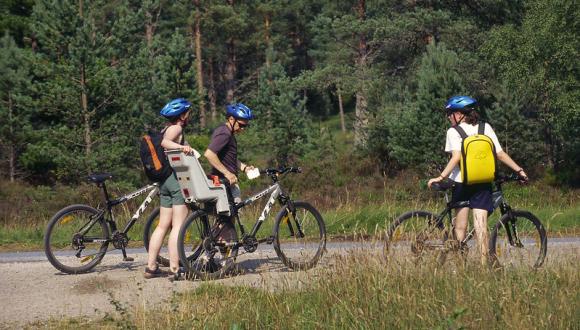Early childhood-nature relations in Scottish school-based outdoor learning
Magnus Magnusson PhD Studentship - Summary
Project Overview
NatureScot’s Magnus Magnusson Studentship supported a PhD research project at the University of Edinburgh’s Moray House School of Education and Sport. This research aimed to learn more about the role nature plays in outdoor learning. This summary report outlines the research conducted by Dr Chris Mackie.
As global education and environmental policies attempt to respond to the interconnected nature and climate emergencies, there is a push to better understand how humans relate to the rest of nature. This is because these relations are thought to affect environmental values, attitudes, and behaviours, which will drive the transition to live within planetary boundaries. Experiences of nature in early childhood have been identified by environmental psychologists and education researchers as potentially influential in how human-nature relations develop throughout life.
In Scotland, outdoor learning and play are supposed to be central to early childhood education (from birth to eight years-old) and are promoted as valuable approaches for delivering Curriculum for Excellence from age 3-18. There is an increasing body of international research investigating young children’s experiences with nature in early learning and childcare (ELC) settings, but limited understanding of how this takes place in the first years of school.
In theory, Scotland’s commitment to Learning for Sustainability, as well as renewed practice guidance for early childhood, makes these first years potentially impactful in shaping how young people relate to nature. Learning for Sustainability aims to incorporate sustainable development education, global citizenship education and outdoor learning through a whole-school approach. However, previous research commissioned by NatureScot suggests that children’s experiences of outdoor learning at primary school are inconsistent and have decreased in frequency and duration between 2014 and 2022.
Because nature is particularly valued for the ways it supports health and wellbeing, play and the development of pro-environmental behaviours, a lot of research focusses on measurable outcomes rather than processes. In contrast, this study tried to document in fine detail how children, teachers and nature come together during everyday outdoor learning experiences. This is important because ‘outdoor learning’ can mean different things to different people and all outdoor learning experiences do not necessarily contribute to healthier human-nature relations or even meaningful and positive educational experiences.
Fieldwork at two schools provided rich observational data which was used alongside existing research and policies to pursue two research objectives. Processes including attending to things together, collecting and play were identified as important, but the findings also show that human-nature relations can be incoherent across different contexts in schools, which may limit the potential for meaningful learning for sustainability. While practice guidance in Scotland appears to support ways of learning outdoors which could have positive impacts on human-nature relations, capacity for this potential to emerge in schools is currently limited by the structure of the school system.
Implications
Schools should consider how nature is represented, indoors and outdoors.
Educators should pay critical attention to how nature is represented and framed in resources, texts, dialogues, play and learning. For example, where nature is presented as separate from humans, or in a utilitarian or extractivist frame, adults should critically consider how or why to incorporate it into their practice. Humans are part of nature and affecting planetary systems on an unprecedented scale; education systems at all levels should acknowledge this and work explicitly towards transformative change in how we relate to the world around us.
Strategies should be developed to nurture play that respects nature and our place in it.
Play is immensely valuable in early childhood. Educational communities, including Initial Teacher Education providers and local authorities should develop strategies to nurture play activity which supports and represents respectful human-nature relations without removing children’s choice and agency. In outdoor learning environments, educators should consider how both adult- and child-initiated play activities can contribute to consideration of and care for nature. It is particularly important to avoid framing nature as something which humans are separate from and can use without consideration or care in return. Critically considering environments, both indoors and out, and what materials and resources do in children’s play is a good starting point in this.
Educators need professional learning and additional support.
For teachers to do all of this and everything that is expected of them meaningfully across the curriculum, additional support in the form of staffing, resources and time is urgently needed. More well trained, experienced adults equipped with a coherent worldview for making sense of human-nature relations in this time of crisis are required.
Educators need to actively support the development of healthy human-nature relations; just going outside isn’t enough.
Early encounters with nature at school can and should be the beginning of a series of progressive experiences which support young people to develop rich and meaningful relations with the world around them. This can start in school grounds and progress to include different outdoor learning environments. However, without a clear educational purpose which prioritises healthy human-nature relations, there is a risk that teachers assume connection or understanding will appear through outdoor learning by default, rather than through skilled attention. The capacity to critically engage with the complexity of our world (in ecological and social terms) is also key.
Holistic approaches are needed at all levels.
To support teachers in this, school leaders and those involved in teacher education should be encouraged to develop approaches (both indoors and outdoors) which nurture respectful relationships with the rest of nature. While this may be more obvious and intuitive in early childhood, as shown in this research, there are implications for all educators.
The Research Process
The research had two objectives:
- Investigate how children and teachers in Scotland come to know the outdoor environments in which they are learning.
- Identify potential pathways and barriers to Learning for Sustainability that emerge during school-based outdoor learning.
The exploratory fieldwork used video and observations to record outdoor learning in school grounds and local greenspaces at two schools. Over three terms, Dr Mackie spent time with four classes; up to 94 children aged between four and seven and their teachers. At one school, outdoor learning and play tended to be undertaken as a whole class, either in a school garden or a nearby woodland. The other school was implementing a play-based approach to Early level curriculum where the three classes involved had access to a central outdoor space throughout the day.
Rather than just focus on the human interactions and meanings that emerged, data collection and analysis aimed to include the non-human beings (such as trees, plants, animals), natural objects (like stones, acorns, sticks) and synthetic objects (such as plastic containers, clothing, toys, tools) which were involved too. Over time, these observations were developed into description-rich writing and images interwoven with policies, practice guidance and international research literature to yield new insights. This type of research is a form of ethnography, which is usually used to understand specific cultural contexts by writing about people. In this study, however, the process tried to consider the non-human aspects of the environments too. This research focussed on early childhood education in just two schools, but the detailed consideration of ‘everyday’ outdoor learning provides insights which can be applied to other contexts in further research and practice.
Findings
Through the process of bringing together writing, images, video clips, fieldwork notes and other literature, the research identified six main topics related to the research objectives.
Multiple emergent ‘natures’, indoors and out.
Nature is not a fixed, universal thing which is only experienced outdoors; it was made sense of by children and teachers in lots of different ways at the two schools in the study; ways which were not always consistent. This included nature as a place to find things, as risky, and as a range of objects to be used. Nature made its way into classrooms through weather and (re)presentational texts like books and videos. In the playgrounds, nature was a place to move and behave in different ways, while in a school garden it was experienced as food and through encounters with other animals.

Collecting
Children and teachers were regularly observed engaging in processes of collecting natural materials. Children collected things for different reasons: due to intrinsic motivations as part of play, for example, or because of directions from a teacher. Collecting is identified as a widespread activity in child-nature relations, but the adults in the study spoke about the natural beings and objects encountered in different ways. This could have implications for how child-nature relations emerge, including how the rest of nature is framed and the scope for ecological understanding. For example, if fallen leaves are collected as a resource for art activities in the classroom, there is direct experience of nature, movement and creativity, but this may create an extractive way of relating to the environment and does not necessarily develop ecological understanding of the specific place or the life cycles of the tree.

Commoning
In educational terms, ‘commoning’ is a process of true communication between individuals who can respond and attend to each other; who create a common world through shared experience and participation. International policy suggests that this should be a core concept to structure educational approaches in the future. Commoning activities can extend to involve non-human things in the environment as well. Effective experiential environmental education can be full of opportunities for this, where intention (knowing what you want to achieve) and attention (noticing and responding to things as you do something) are balanced.
In the study, the main commoning activities centred around showing; talking and listening; gardening and playing. However, there were limited instances where child, teacher and non-human beings/objects all came together in ways which supported the types of attention which lead to care for and understanding of nature. Fieldwork observations highlighted how important the socio-cultural and ecological framing and modelling of human-nature relations by the teacher is in developing these characteristics.

Joint attention (where adults and children notice or attend to something together) is potentially a very important developmental pathway in human-nature relations, and children were observed expressing a need for this from the adults around them. This created significant demand on teacher attention with typical school class sizes, minimising the potential for impactful adult participation. Connected to this, a lack of effective ways of explaining/understanding nature made it hard for teachers to shape respectful human-nature relations through sustained shared attention. The main frames observed for understanding nature were related to ‘using’ or ‘looking after’. Ecology, the study of relationships and energy flows in an ecosystem, seems to offer a way of understanding the world together which is well suited to this, but depends on knowledge and understanding which teachers did not feel confident applying.

Play and Pedagogy
Play was a very important way for children to relate with outdoor environments and was highly valued by teachers at both schools, albeit in different ways. Play-based learning takes different forms along a continuum moving from children’s self-selected play to adult-framed activities. At one school, play was often seen as distinct from educational ‘work’, and tended to be open-ended and child-directed, with the whole class outdoors at once. At the other school, where children had free-flow access to an outdoor space, play was seen as the primary mode of learning and teaching, and children had more choice about when and how much time they spent outside. There, children experienced more of the play continuum indoors, while their outdoor play tended to be open-ended. Teacher availability outside was limited by the needs of the class indoors and the effects of the winter weather on the outdoor environment.
There was consistency to outdoor play patterns over time, with children returning to places and activities across long periods of time. This implied that children were building on and extending prior play experiences specific to the environment. Depending on approaches to learning and teaching, and the form of play activity, the environment and educators can take on more or less significant roles, which affects educational experiences.
When the dominant form of play was open-ended and child-directed, there were limited opportunities for teachers to involve themselves in the vibrancy of play in ways which might develop closer, caring relations with nature or ecological awareness. Modelled-play and purposefully-framed play have significant value, particularly in developing content knowledge, but using these approaches outdoors requires the adult to be skilled and, crucially, able to be attentive and present. This is challenging when either working with a whole class outside or splitting attention across free-flow spaces. Consistent socio-cultural and ethical frameworks (i.e. how we act towards other living beings and why) are important to ensure that play experiences are educative and not miseducative.

Synthetic materials in outdoor learning environments
Where children had opportunities for free play, the environment was observed to have a significant impact on activity. In more natural environments this obviously has to do with the materials or the landforms. However, not everything outside is ‘natural’.

Driven by good intentions and sound research showing the multiple benefits of outdoor and loose parts play, there are also a lot of synthetic materials and objects in school outdoor learning environments. These are stimulating, fun, and can create rich play, but without additional socio-cultural and ecological context do not necessarily have a direct positive influence on child-nature relations. As well as 'open-ended’ materials, such as tyres, pallets and ropes, specific toys and costumes affected play patterns: a toy chainsaw affords the potential for cutting down trees; spades and builder’s helmets afford the potential for digging. But what are the stories which drive these activities?
When critically accepted as part of the reality of contemporary childhoods, the presence of all this ‘stuff’ can be useful, and the processes associated with loose parts play, such as being creative, re-using materials, communicating and collaborating, all have a place in Learning for Sustainability. However, when not critically engaged with, this may result in schools assuming that by playing and learning ‘outdoors’ children are relating with living nature, when they may be doing the opposite. In one school there was more awareness of how resources shaped play, and the teacher’s role in this to develop educative experiences, but there was limited capacity for teachers to scaffold play with contexts for sustainability.
Realising the Ambition and Learning for Sustainability
If outdoor learning is to be part of meaningful Learning for Sustainability in early childhood, educators need to feel able and confident to connect local direct experiences of nature with global systems and ways of being. Realising the Ambition, the most recent national practice guidance for early childhood education in Scotland, is well suited to developing the forms of activity which may support commoning between children, teachers, and nature, especially in ELC settings. The effects of Realising the Ambition’s core elements of horizontal transitions (between environments and activities) and interactions, experiences and spaces which were observed in fieldwork offer a useful framework for thinking about ways of being with nature in different contexts at school.
However, the vertical transition from ELC to Primary One is significant, most noticeably in how it limits the availability of adults in child-nature relations, which is essential for teachers to ensure outdoor learning experiences are educative. In ELC settings, the adult:child ratio should not exceed 1:8 for sessions of four or more hours while a single Primary One teacher may be working with up to 25 children. It could be argued that increased adult availability is an underacknowledged factor in outdoor learning research literature, which often draws on data from off-site contexts with specialist input, extra staff, or parent volunteers, which contrasts with everyday practice in schools.
If our society expects teachers to employ the type of pedagogy outlined in Realising the Ambition alongside the purpose of rapid transformative social change for sustainability, two key components will are necessary. First is a coherent and accessible way of understanding and communicating about non-human nature, and the second is more adults who can share that, working both in and out of classrooms.
This research was conducted by Dr Chris Mackie at The University of Edinburgh with the support of NatureScot and the Magnus Magnusson Studentship.
Chris would like to thank the teachers, children and communities who participated in this project, as well as Dr Pete Rawcliffe, Dr Beth Christie and Professor Pete Higgins.
Related Links
- Read the thesis: Diffractive ethnography of early childhood-nature relations in Scottish school-based outdoor learning
- Moray House, Outdoor and Environmental Education





